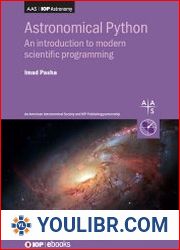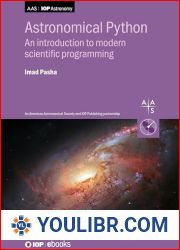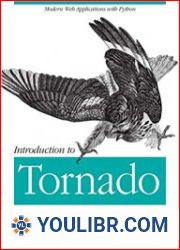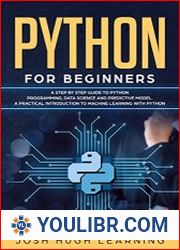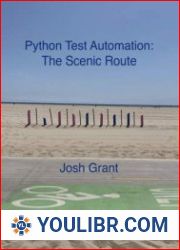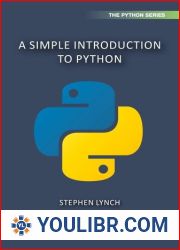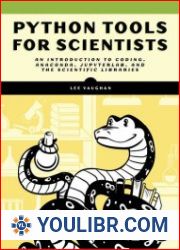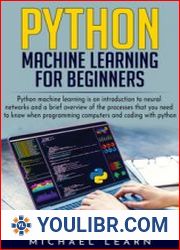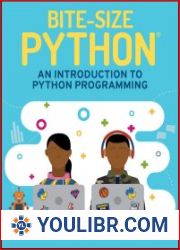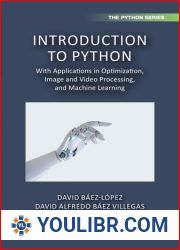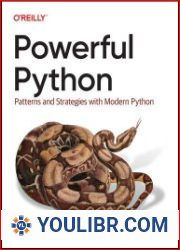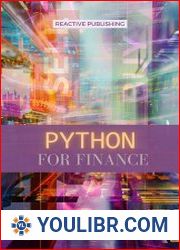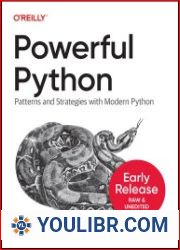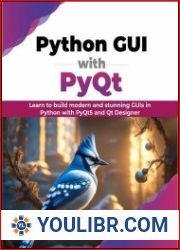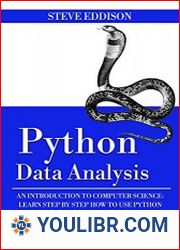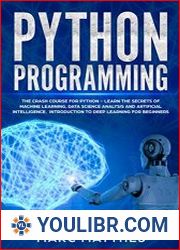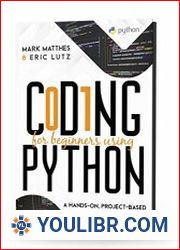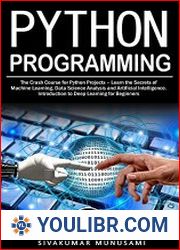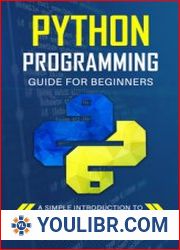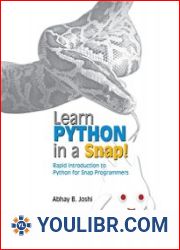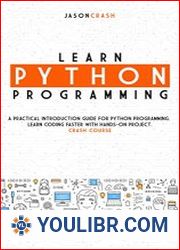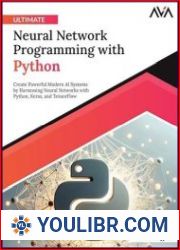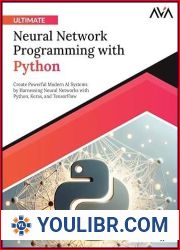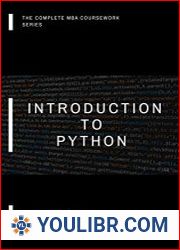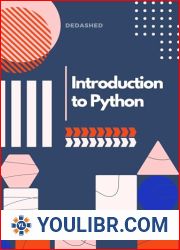
BOOKS - Astronomical Python An introduction to modern scientific programming

Astronomical Python An introduction to modern scientific programming
Author: Imad Pasha
Year: 2024
Format: PDF | EPUB
File size: 48.1 MB
Language: ENG
Year: 2024
Format: PDF | EPUB
File size: 48.1 MB
Language: ENG
Over the past two decades, Python has become the de facto standard language of Data Science both in industry and astronomy (with the exception of simulations and other extreme scale computing problems). This course text is a full introduction to programming in Python with an explicit focus on astrophysical applications. The book covers the fundamentals of Python, including the native data types and operations, and how the language, interpreter, and operating system work together. Leaning heavily on standard packages used in astronomy, the book covers the installation and basic structure of the language and libraries; script writing, conditional statements, loops, and other code structures that allow for complex outcome management; the creation and use of functions and classes within Python; the creation of packages and the methods for re-using, importing, and otherwise standardizing code; and plotting. Finally, the book contains several higher level chapters that carry students from the beginner stage of programming into the intermediate. This book will cover the native data types and operations, and how the language, interpreter, and operating system work together to carry out commands. The book will lean heavily on standard packages (libraries of functions and classes) used in our field, including Numpy, SciPy, Matplotlib, and Astropy. After discussing the installation and basic structure of the language and libraries, the text will move into a discussion of script writing, conditional statements, loops, and other code structures that allow for complex outcome management. The text will then discuss the creation and use of functions and classes within Python, which enables unit-testing and more robust and ?exible code creation, and use these tools in a Data Science context on an astronomical survey.
Book: Astronomical Python - An Introduction to Modern Scientific Programming Introduction: In the past two decades, Python has emerged as the de facto standard language of Data Science, both in industry and astronomy, with the exception of simulations and other extreme scale computing problems. This comprehensive introduction to programming in Python is designed specifically for astronomers, focusing on the fundamental concepts and practical applications in astrophysics. The book covers the installation and basic structure of the language and libraries, script writing, conditional statements, loops, and other code structures that enable complex outcome management. It also delves into the creation and use of functions and classes within Python, enabling unit testing and more robust and flexible code. Chapter 1: The Evolution of Technology and its Impact on Human Survival The rapid evolution of technology has transformed the way we live, work, and communicate. However, this technological advancement has also brought about new challenges and threats to human survival. In order to survive and thrive in this rapidly changing world, it is essential to develop a personal paradigm for perceiving the technological process of developing modern knowledge. This chapter explores the need and possibility of developing such a paradigm, highlighting the importance of understanding the technological process as the basis for human survival. Chapter 2: The Role of Astronomy in Modern Society Astronomy has played a crucial role in shaping our understanding of the universe and our place within it. Book: Astronomical Python - An Introduction to Modern Scientific Programming Introduction: В последние два десятилетия Python стал де-факто стандартным языком Data Science, как в промышленности, так и в астрономии, за исключением моделирования и других экстремальных вычислительных задач. Это всеобъемлющее введение в программирование на Python разработано специально для астрономов, фокусируясь на фундаментальных концепциях и практических приложениях в астрофизике. Книга охватывает установку и базовую структуру языка и библиотек, написание сценариев, условные операторы, циклы и другие структуры кода, которые обеспечивают сложное управление результатами. Он также углубляется в создание и использование функций и классов в Python, обеспечивая модульное тестирование и более надежный и гибкий код. Глава 1: Эволюция технологий и ее влияние на выживание человека Быстрая эволюция технологий изменила то, как мы живем, работаем и общаемся. Однако этот технологический прогресс также привел к новым вызовам и угрозам для выживания человека. Чтобы выжить и процветать в этом быстро меняющемся мире, необходимо разработать личную парадигму восприятия технологического процесса развития современных знаний. В этой главе исследуется необходимость и возможность разработки такой парадигмы, подчеркивая важность понимания технологического процесса как основы выживания человека. Глава 2: Роль астрономии в современном обществе Астрономия сыграла решающую роль в формировании нашего понимания Вселенной и нашего места в ней. download pdf file 下载 pdf 文件 descargar archivo pdf להוריד קובץ PDF download pdf file pobierz plik pdf Scarica il file pdf pdf dosyasını indir PDF-Datei herunterladen скачать файл PDF تنزيل ملف pdf descarregar ficheiro pdf pdf 파일 다운로드 télécharger le fichier pdf PDFファイルをダウンロード
En las últimas dos décadas, Python se ha convertido en el lenguaje estándar de facto de Data Science tanto en la industria como en la astronomía (excepto en simulaciones y otros problemas informáticos extremos). Este texto del curso es una introducción completa a la programación en Python con un claro énfasis en las aplicaciones astrofísicas. El libro cubre los fundamentos de Python, incluidos los tipos de datos nativos y las operaciones, así como la forma en que el lenguaje, el intérprete y el sistema operativo trabajan juntos. Basándose en gran medida en los paquetes estándar utilizados en astronomía, el libro abarca la instalación y la estructura básica del lenguaje y las bibliotecas; escritura de scripts, operadores condicionales, ciclos y otras estructuras de código que proporcionan una gestión de resultados compleja; creación y uso de funciones y clases dentro de Python; Creación de paquetes y métodos de reutilización, importación y otra normalización del código; y la construcción de gráficos. Por último, el libro contiene varios capítulos de nivel superior que trasladan a los alumnos de la fase inicial de programación a la intermedia. Este libro examinará los tipos de datos y operaciones propios, así como la forma en que el lenguaje, el intérprete y el sistema operativo trabajan juntos para ejecutar los comandos. El libro se basará en gran medida en los paquetes estándar (bibliotecas de funciones y clases) utilizados en nuestro campo, incluyendo Numpy, SciPy, Matplotlib y Astropy. Después de discutir la instalación y la estructura básica del lenguaje y las bibliotecas, el texto pasará a discutir la escritura de scripts, operadores condicionales, ciclos y otras estructuras de código que permiten una compleja administración de resultados. A continuación, el texto analizará la creación y uso de funciones y clases en Python, lo que permite realizar pruebas modulares y crear un código más fiable y flexible, así como utilizar estas herramientas en el contexto de Data Science en una revisión astronómica.
За последние два десятилетия Python стал де-факто стандартным языком Data Science как в промышленности, так и в астрономии (за исключением симуляций и других экстремальных вычислительных задач). Этот текст курса является полным введением в программирование на Python с явным акцентом на астрофизические приложения. Книга охватывает основы Python, включая нативные типы данных и операции, а также то, как язык, интерпретатор и операционная система работают вместе. Опираясь в значительной степени на стандартные пакеты, используемые в астрономии, книга охватывает установку и базовую структуру языка и библиотек; написание сценариев, условные операторы, циклы и другие структуры кода, которые обеспечивают сложное управление результатами; создание и использование функций и классов внутри Python; создание пакетов и методов повторного использования, импорта и иной стандартизации кода; и построение графиков. Наконец, книга содержит несколько глав более высокого уровня, переносящих студентов из начального этапа программирования в промежуточный. В этой книге будут рассмотрены собственные типы данных и операции, а также то, как язык, интерпретатор и операционная система работают вместе для выполнения команд. Книга будет в значительной степени опираться на стандартные пакеты (библиотеки функций и классов), используемые в нашей области, включая Numpy, SciPy, Matplotlib и Astropy. После обсуждения установки и базовой структуры языка и библиотек текст перейдет к обсуждению написания сценариев, условных операторов, циклов и других структур кода, позволяющих осуществлять сложное управление результатами. Затем в тексте будет обсуждаться создание и использование функций и классов в Python, что позволяет проводить модульное тестирование и создавать более надежный и гибкий код, а также использовать эти инструменты в контексте Data Science в астрономическом обзоре.
Nas últimas duas décadas, Python tornou-se, de facto, a linguagem padrão do Data Science na indústria e na astronomia (exceto simulações e outras tarefas de computação extremas). Este texto do curso é uma introdução completa na programação em Python, com foco explícito em aplicativos astrofísicos. O livro abrange os fundamentos do Python, incluindo os tipos de dados nativos e as operações, e a forma como o idioma, o intérprete e o sistema operacional funcionam juntos. Baseado em grande parte nos pacotes padrão usados na astronomia, o livro abrange a instalação e a estrutura básica da língua e bibliotecas; a escrita de cenários, operadores condicional, ciclos e outras estruturas de código que fornecem uma gestão complexa dos resultados; criar e usar funções e classes dentro do Python; criar pacotes e métodos de reutilização, importação e outra normalização de código; e a construção de gráficos. Finalmente, o livro contém vários capítulos de nível superior que levam estudantes da fase inicial de programação para a fase intermediária. Este livro abordará os seus próprios tipos de dados e operações e como linguagem, intérprete e sistema operacional trabalham juntos para executar comandos. O livro será baseado em pacotes padrão (bibliotecas de funções e classes) usados em nossa área, incluindo Numpy, SciPy, Matplotlib e Astropy. Depois de discutir a instalação e a estrutura básica do idioma e das bibliotecas, o texto passará a discutir a escrita de cenários, operadores condicionais, ciclos e outras estruturas de código que permitam a gestão complexa dos resultados. Em seguida, o texto discutirá a criação e utilização de funções e classes no Python, permitindo a realização de testes modulares e a criação de um código mais confiável e flexível e a utilização dessas ferramentas no contexto Data Science em uma revisão astronômica.
Au cours des deux dernières décennies, Python est devenu de facto le langage standard de Data Science dans l'industrie et l'astronomie (à l'exception des simulations et d'autres tâches informatiques extrêmes). Ce texte de cours est une introduction complète à la programmation en Python, avec un accent clair sur les applications astrophysiques. Le livre couvre les bases de Python, y compris les types de données natives et les opérations, ainsi que la façon dont le langage, l'interprète et le système d'exploitation fonctionnent ensemble. S'appuyant en grande partie sur les paquets standard utilisés en astronomie, le livre couvre l'installation et la structure de base du langage et des bibliothèques ; écriture de scénarios, opérateurs conditionnels, boucles et autres structures de code qui assurent une gestion complexe des résultats ; Créer et utiliser des fonctions et des classes au sein de Python ; la création de paquets et de méthodes de réutilisation, d'importation et de normalisation du code ; et l'établissement de graphiques. Enfin, le livre contient plusieurs chapitres de niveau supérieur transférant les étudiants de la phase initiale de programmation à la phase intermédiaire. Ce livre examinera les types de données et les opérations propres, ainsi que la façon dont le langage, l'interprète et le système d'exploitation travaillent ensemble pour exécuter les commandes. Le livre s'appuiera largement sur les paquets standard (bibliothèques de fonctions et de classes) utilisés dans notre domaine, y compris Numpy, SciPy, Matplotlib et Astropy. Après avoir discuté de l'installation et de la structure de base du langage et des bibliothèques, le texte passe à l'écriture de scripts, d'opérateurs conditionnels, de cycles et d'autres structures de code qui permettent une gestion complexe des résultats. Le texte discutera ensuite de la création et de l'utilisation de fonctions et de classes dans Python, ce qui permet de réaliser des tests modulaires et de créer un code plus fiable et plus flexible, ainsi que d'utiliser ces outils dans le contexte de Data Science dans une revue astronomique.
In den letzten zwei Jahrzehnten ist Python sowohl in der Industrie als auch in der Astronomie de facto zur Standardsprache der Data Science geworden (mit Ausnahme von Simulationen und anderen extremen Rechenaufgaben). Dieser Kurstext ist eine vollständige Einführung in die Python-Programmierung mit einem klaren Fokus auf astrophysikalische Anwendungen. Das Buch behandelt die Grundlagen von Python, einschließlich nativer Datentypen und Operationen, und wie Sprache, Interpreter und Betriebssystem zusammenarbeiten. Das Buch stützt sich weitgehend auf Standardpakete, die in der Astronomie verwendet werden, und behandelt die Installation und die grundlegende Struktur von Sprache und Bibliotheken. Schreiben von Skripten, bedingten Anweisungen, Schleifen und anderen Codestrukturen, die eine komplexe Verwaltung der Ergebnisse ermöglichen; Erstellen und Verwenden von Funktionen und Klassen innerhalb von Python Erstellung von Paketen und Methoden für die Wiederverwendung, den Import und andere Standardisierung des Codes; und Plotten. Schließlich enthält das Buch mehrere Kapitel auf höherer Ebene, die die Schüler von der anfänglichen Programmierphase bis zur Zwischenstufe führen. Dieses Buch wird die nativen Datentypen und Operationen untersuchen und wie Sprache, Interpreter und Betriebssystem zusammenarbeiten, um Befehle auszuführen. Das Buch wird sich stark auf die Standardpakete (Funktions- und Klassenbibliotheken) stützen, die in unserem Bereich verwendet werden, einschließlich Numpy, SciPy, Matplotlib und Astropy. Nach einer Diskussion über die Installation und die grundlegende Struktur von Sprache und Bibliotheken wird der Text zu einer Diskussion über das Schreiben von Skripten, bedingten Anweisungen, Schleifen und anderen Codestrukturen übergehen, die eine komplexe Verwaltung der Ergebnisse ermöglichen. Der Text wird dann die Erstellung und Verwendung von Funktionen und Klassen in Python diskutieren, was es ermöglicht, modulare Tests durchzuführen und robusteren und flexibleren Code zu erstellen sowie diese Werkzeuge im Kontext von Data Science in einer astronomischen Überprüfung zu verwenden.
Over the past two decades, Python has become the de facto standard language of Data Science both in industry and astronomy (with the exception of simulations and other extreme scale computing problems). This course text is a full introduction to programming in Python with an explicit focus on astrophysical applications. The book covers the fundamentals of Python, including the native data types and operations, and how the language, interpreter, and operating system work together. Leaning heavily on standard packages used in astronomy, the book covers the installation and basic structure of the language and libraries; script writing, conditional statements, loops, and other code structures that allow for complex outcome management; the creation and use of functions and classes within Python; the creation of packages and the methods for re-using, importing, and otherwise standardizing code; and plotting. Finally, the book contains several higher level chapters that carry students from the beginner stage of programming into the intermediate. This book will cover the native data types and operations, and how the language, interpreter, and operating system work together to carry out commands. The book will lean heavily on standard packages (libraries of functions and classes) used in our field, including Numpy, SciPy, Matplotlib, and Astropy. After discussing the installation and basic structure of the language and libraries, the text will move into a discussion of script writing, conditional statements, loops, and other code structures that allow for complex outcome management. The text will then discuss the creation and use of functions and classes within Python, which enables unit-testing and more robust and ?exible code creation, and use these tools in a Data Science context on an astronomical survey.
En las últimas dos décadas, Python se ha convertido en el lenguaje estándar de facto de Data Science tanto en la industria como en la astronomía (excepto en simulaciones y otros problemas informáticos extremos). Este texto del curso es una introducción completa a la programación en Python con un claro énfasis en las aplicaciones astrofísicas. El libro cubre los fundamentos de Python, incluidos los tipos de datos nativos y las operaciones, así como la forma en que el lenguaje, el intérprete y el sistema operativo trabajan juntos. Basándose en gran medida en los paquetes estándar utilizados en astronomía, el libro abarca la instalación y la estructura básica del lenguaje y las bibliotecas; escritura de scripts, operadores condicionales, ciclos y otras estructuras de código que proporcionan una gestión de resultados compleja; creación y uso de funciones y clases dentro de Python; Creación de paquetes y métodos de reutilización, importación y otra normalización del código; y la construcción de gráficos. Por último, el libro contiene varios capítulos de nivel superior que trasladan a los alumnos de la fase inicial de programación a la intermedia. Este libro examinará los tipos de datos y operaciones propios, así como la forma en que el lenguaje, el intérprete y el sistema operativo trabajan juntos para ejecutar los comandos. El libro se basará en gran medida en los paquetes estándar (bibliotecas de funciones y clases) utilizados en nuestro campo, incluyendo Numpy, SciPy, Matplotlib y Astropy. Después de discutir la instalación y la estructura básica del lenguaje y las bibliotecas, el texto pasará a discutir la escritura de scripts, operadores condicionales, ciclos y otras estructuras de código que permiten una compleja administración de resultados. A continuación, el texto analizará la creación y uso de funciones y clases en Python, lo que permite realizar pruebas modulares y crear un código más fiable y flexible, así como utilizar estas herramientas en el contexto de Data Science en una revisión astronómica.
За последние два десятилетия Python стал де-факто стандартным языком Data Science как в промышленности, так и в астрономии (за исключением симуляций и других экстремальных вычислительных задач). Этот текст курса является полным введением в программирование на Python с явным акцентом на астрофизические приложения. Книга охватывает основы Python, включая нативные типы данных и операции, а также то, как язык, интерпретатор и операционная система работают вместе. Опираясь в значительной степени на стандартные пакеты, используемые в астрономии, книга охватывает установку и базовую структуру языка и библиотек; написание сценариев, условные операторы, циклы и другие структуры кода, которые обеспечивают сложное управление результатами; создание и использование функций и классов внутри Python; создание пакетов и методов повторного использования, импорта и иной стандартизации кода; и построение графиков. Наконец, книга содержит несколько глав более высокого уровня, переносящих студентов из начального этапа программирования в промежуточный. В этой книге будут рассмотрены собственные типы данных и операции, а также то, как язык, интерпретатор и операционная система работают вместе для выполнения команд. Книга будет в значительной степени опираться на стандартные пакеты (библиотеки функций и классов), используемые в нашей области, включая Numpy, SciPy, Matplotlib и Astropy. После обсуждения установки и базовой структуры языка и библиотек текст перейдет к обсуждению написания сценариев, условных операторов, циклов и других структур кода, позволяющих осуществлять сложное управление результатами. Затем в тексте будет обсуждаться создание и использование функций и классов в Python, что позволяет проводить модульное тестирование и создавать более надежный и гибкий код, а также использовать эти инструменты в контексте Data Science в астрономическом обзоре.
Nas últimas duas décadas, Python tornou-se, de facto, a linguagem padrão do Data Science na indústria e na astronomia (exceto simulações e outras tarefas de computação extremas). Este texto do curso é uma introdução completa na programação em Python, com foco explícito em aplicativos astrofísicos. O livro abrange os fundamentos do Python, incluindo os tipos de dados nativos e as operações, e a forma como o idioma, o intérprete e o sistema operacional funcionam juntos. Baseado em grande parte nos pacotes padrão usados na astronomia, o livro abrange a instalação e a estrutura básica da língua e bibliotecas; a escrita de cenários, operadores condicional, ciclos e outras estruturas de código que fornecem uma gestão complexa dos resultados; criar e usar funções e classes dentro do Python; criar pacotes e métodos de reutilização, importação e outra normalização de código; e a construção de gráficos. Finalmente, o livro contém vários capítulos de nível superior que levam estudantes da fase inicial de programação para a fase intermediária. Este livro abordará os seus próprios tipos de dados e operações e como linguagem, intérprete e sistema operacional trabalham juntos para executar comandos. O livro será baseado em pacotes padrão (bibliotecas de funções e classes) usados em nossa área, incluindo Numpy, SciPy, Matplotlib e Astropy. Depois de discutir a instalação e a estrutura básica do idioma e das bibliotecas, o texto passará a discutir a escrita de cenários, operadores condicionais, ciclos e outras estruturas de código que permitam a gestão complexa dos resultados. Em seguida, o texto discutirá a criação e utilização de funções e classes no Python, permitindo a realização de testes modulares e a criação de um código mais confiável e flexível e a utilização dessas ferramentas no contexto Data Science em uma revisão astronômica.
Au cours des deux dernières décennies, Python est devenu de facto le langage standard de Data Science dans l'industrie et l'astronomie (à l'exception des simulations et d'autres tâches informatiques extrêmes). Ce texte de cours est une introduction complète à la programmation en Python, avec un accent clair sur les applications astrophysiques. Le livre couvre les bases de Python, y compris les types de données natives et les opérations, ainsi que la façon dont le langage, l'interprète et le système d'exploitation fonctionnent ensemble. S'appuyant en grande partie sur les paquets standard utilisés en astronomie, le livre couvre l'installation et la structure de base du langage et des bibliothèques ; écriture de scénarios, opérateurs conditionnels, boucles et autres structures de code qui assurent une gestion complexe des résultats ; Créer et utiliser des fonctions et des classes au sein de Python ; la création de paquets et de méthodes de réutilisation, d'importation et de normalisation du code ; et l'établissement de graphiques. Enfin, le livre contient plusieurs chapitres de niveau supérieur transférant les étudiants de la phase initiale de programmation à la phase intermédiaire. Ce livre examinera les types de données et les opérations propres, ainsi que la façon dont le langage, l'interprète et le système d'exploitation travaillent ensemble pour exécuter les commandes. Le livre s'appuiera largement sur les paquets standard (bibliothèques de fonctions et de classes) utilisés dans notre domaine, y compris Numpy, SciPy, Matplotlib et Astropy. Après avoir discuté de l'installation et de la structure de base du langage et des bibliothèques, le texte passe à l'écriture de scripts, d'opérateurs conditionnels, de cycles et d'autres structures de code qui permettent une gestion complexe des résultats. Le texte discutera ensuite de la création et de l'utilisation de fonctions et de classes dans Python, ce qui permet de réaliser des tests modulaires et de créer un code plus fiable et plus flexible, ainsi que d'utiliser ces outils dans le contexte de Data Science dans une revue astronomique.
In den letzten zwei Jahrzehnten ist Python sowohl in der Industrie als auch in der Astronomie de facto zur Standardsprache der Data Science geworden (mit Ausnahme von Simulationen und anderen extremen Rechenaufgaben). Dieser Kurstext ist eine vollständige Einführung in die Python-Programmierung mit einem klaren Fokus auf astrophysikalische Anwendungen. Das Buch behandelt die Grundlagen von Python, einschließlich nativer Datentypen und Operationen, und wie Sprache, Interpreter und Betriebssystem zusammenarbeiten. Das Buch stützt sich weitgehend auf Standardpakete, die in der Astronomie verwendet werden, und behandelt die Installation und die grundlegende Struktur von Sprache und Bibliotheken. Schreiben von Skripten, bedingten Anweisungen, Schleifen und anderen Codestrukturen, die eine komplexe Verwaltung der Ergebnisse ermöglichen; Erstellen und Verwenden von Funktionen und Klassen innerhalb von Python Erstellung von Paketen und Methoden für die Wiederverwendung, den Import und andere Standardisierung des Codes; und Plotten. Schließlich enthält das Buch mehrere Kapitel auf höherer Ebene, die die Schüler von der anfänglichen Programmierphase bis zur Zwischenstufe führen. Dieses Buch wird die nativen Datentypen und Operationen untersuchen und wie Sprache, Interpreter und Betriebssystem zusammenarbeiten, um Befehle auszuführen. Das Buch wird sich stark auf die Standardpakete (Funktions- und Klassenbibliotheken) stützen, die in unserem Bereich verwendet werden, einschließlich Numpy, SciPy, Matplotlib und Astropy. Nach einer Diskussion über die Installation und die grundlegende Struktur von Sprache und Bibliotheken wird der Text zu einer Diskussion über das Schreiben von Skripten, bedingten Anweisungen, Schleifen und anderen Codestrukturen übergehen, die eine komplexe Verwaltung der Ergebnisse ermöglichen. Der Text wird dann die Erstellung und Verwendung von Funktionen und Klassen in Python diskutieren, was es ermöglicht, modulare Tests durchzuführen und robusteren und flexibleren Code zu erstellen sowie diese Werkzeuge im Kontext von Data Science in einer astronomischen Überprüfung zu verwenden.
Over the past two decades, Python has become the de facto standard language of Data Science both in industry and astronomy (with the exception of simulations and other extreme scale computing problems). This course text is a full introduction to programming in Python with an explicit focus on astrophysical applications. The book covers the fundamentals of Python, including the native data types and operations, and how the language, interpreter, and operating system work together. Leaning heavily on standard packages used in astronomy, the book covers the installation and basic structure of the language and libraries; script writing, conditional statements, loops, and other code structures that allow for complex outcome management; the creation and use of functions and classes within Python; the creation of packages and the methods for re-using, importing, and otherwise standardizing code; and plotting. Finally, the book contains several higher level chapters that carry students from the beginner stage of programming into the intermediate. This book will cover the native data types and operations, and how the language, interpreter, and operating system work together to carry out commands. The book will lean heavily on standard packages (libraries of functions and classes) used in our field, including Numpy, SciPy, Matplotlib, and Astropy. After discussing the installation and basic structure of the language and libraries, the text will move into a discussion of script writing, conditional statements, loops, and other code structures that allow for complex outcome management. The text will then discuss the creation and use of functions and classes within Python, which enables unit-testing and more robust and ?exible code creation, and use these tools in a Data Science context on an astronomical survey.







